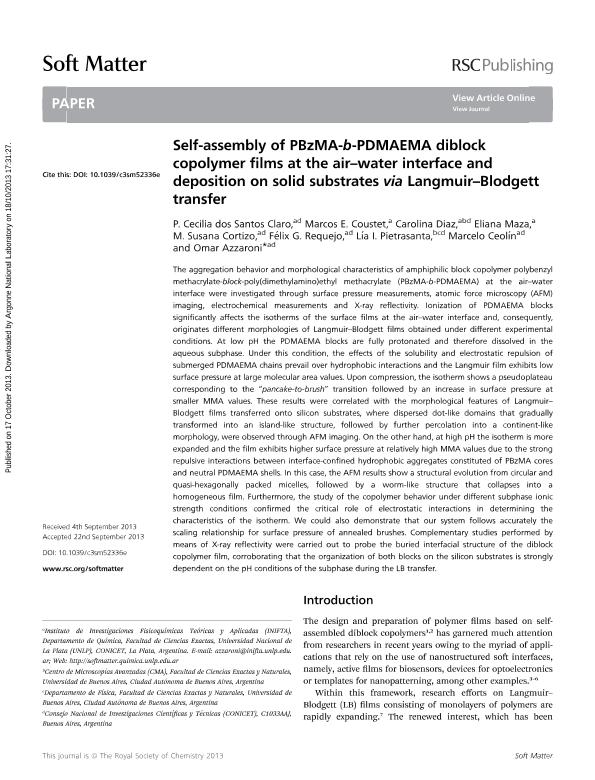Artículo
Self-assembly of PBzMA-b-PDMAEMA diblock copolymer films at the air/water interface and deposition on solid substrates via Langmuir-Blodgett transfer
Dos Santos Claro, Paula Cecilia ; Coustet, Marcos Eduardo
; Coustet, Marcos Eduardo ; Diaz, Carolina
; Diaz, Carolina ; Maza, Eliana María
; Maza, Eliana María ; Cortizo, Maria Susana
; Cortizo, Maria Susana ; Requejo, Felix Gregorio
; Requejo, Felix Gregorio ; Pietrasanta, Lia
; Pietrasanta, Lia ; Ceolin, Marcelo Raul
; Ceolin, Marcelo Raul ; Azzaroni, Omar
; Azzaroni, Omar
 ; Coustet, Marcos Eduardo
; Coustet, Marcos Eduardo ; Diaz, Carolina
; Diaz, Carolina ; Maza, Eliana María
; Maza, Eliana María ; Cortizo, Maria Susana
; Cortizo, Maria Susana ; Requejo, Felix Gregorio
; Requejo, Felix Gregorio ; Pietrasanta, Lia
; Pietrasanta, Lia ; Ceolin, Marcelo Raul
; Ceolin, Marcelo Raul ; Azzaroni, Omar
; Azzaroni, Omar
Fecha de publicación:
10/2013
Editorial:
Royal Society of Chemistry
Revista:
Soft Matter
ISSN:
1744-683X
Idioma:
Inglés
Tipo de recurso:
Artículo publicado
Clasificación temática:
Resumen
The aggregation behavior and morphological characteristics of amphiphilic block copolymer polybenzyl methacrylate-block-poly(dimethylamino)ethyl methacrylate (PBzMA-b-PDMAEMA) at the air-water interface were investigated through surface pressure measurements, atomic force microscopy (AFM) imaging, electrochemical measurements and X-ray reflectivity. Ionization of PDMAEMA blocks significantly affects the isotherms of the surface films at the air-water interface and, consequently, originates different morphologies of Langmuir-Blodgett films obtained under different experimental conditions. At low pH the PDMAEMA blocks are fully protonated and therefore dissolved in the aqueous subphase. Under this condition, the effects of the solubility and electrostatic repulsion of submerged PDMAEMA chains prevail over hydrophobic interactions and the Langmuir film exhibits low surface pressure at large molecular area values. Upon compression, the isotherm shows a pseudoplateau corresponding to the "pancake-to-brush" transition followed by an increase in surface pressure at smaller MMA values. These results were correlated with the morphological features of Langmuir-Blodgett films transferred onto silicon substrates, where dispersed dot-like domains that gradually transformed into an island-like structure, followed by further percolation into a continent-like morphology, were observed through AFM imaging. On the other hand, at high pH the isotherm is more expanded and the film exhibits higher surface pressure at relatively high MMA values due to the strong repulsive interactions between interface-confined hydrophobic aggregates constituted of PBzMA cores and neutral PDMAEMA shells. In this case, the AFM results show a structural evolution from circular and quasi-hexagonally packed micelles, followed by a worm-like structure that collapses into a homogeneous film. Furthermore, the study of the copolymer behavior under different subphase ionic strength conditions confirmed the critical role of electrostatic interactions in determining the characteristics of the isotherm. We could also demonstrate that our system follows accurately the scaling relationship for surface pressure of annealed brushes. Complementary studies performed by means of X-ray reflectivity were carried out to probe the buried interfacial structure of the diblock copolymer film, corroborating that the organization of both blocks on the silicon substrates is strongly dependent on the pH conditions of the subphase during the LB transfer.
Archivos asociados
Licencia
Identificadores
Colecciones
Articulos(INIFTA)
Articulos de INST.DE INV.FISICOQUIMICAS TEORICAS Y APLIC.
Articulos de INST.DE INV.FISICOQUIMICAS TEORICAS Y APLIC.
Articulos(OCA CIUDAD UNIVERSITARIA)
Articulos de OFICINA DE COORDINACION ADMINISTRATIVA CIUDAD UNIVERSITARIA
Articulos de OFICINA DE COORDINACION ADMINISTRATIVA CIUDAD UNIVERSITARIA
Articulos(SEDE CENTRAL)
Articulos de SEDE CENTRAL
Articulos de SEDE CENTRAL
Citación
Dos Santos Claro, Paula Cecilia; Coustet, Marcos Eduardo; Diaz, Carolina; Maza, Eliana María; Cortizo, Maria Susana; et al.; Self-assembly of PBzMA-b-PDMAEMA diblock copolymer films at the air/water interface and deposition on solid substrates via Langmuir-Blodgett transfer; Royal Society of Chemistry; Soft Matter; 9; 45; 10-2013; 10899-10912
Compartir
Altmétricas



